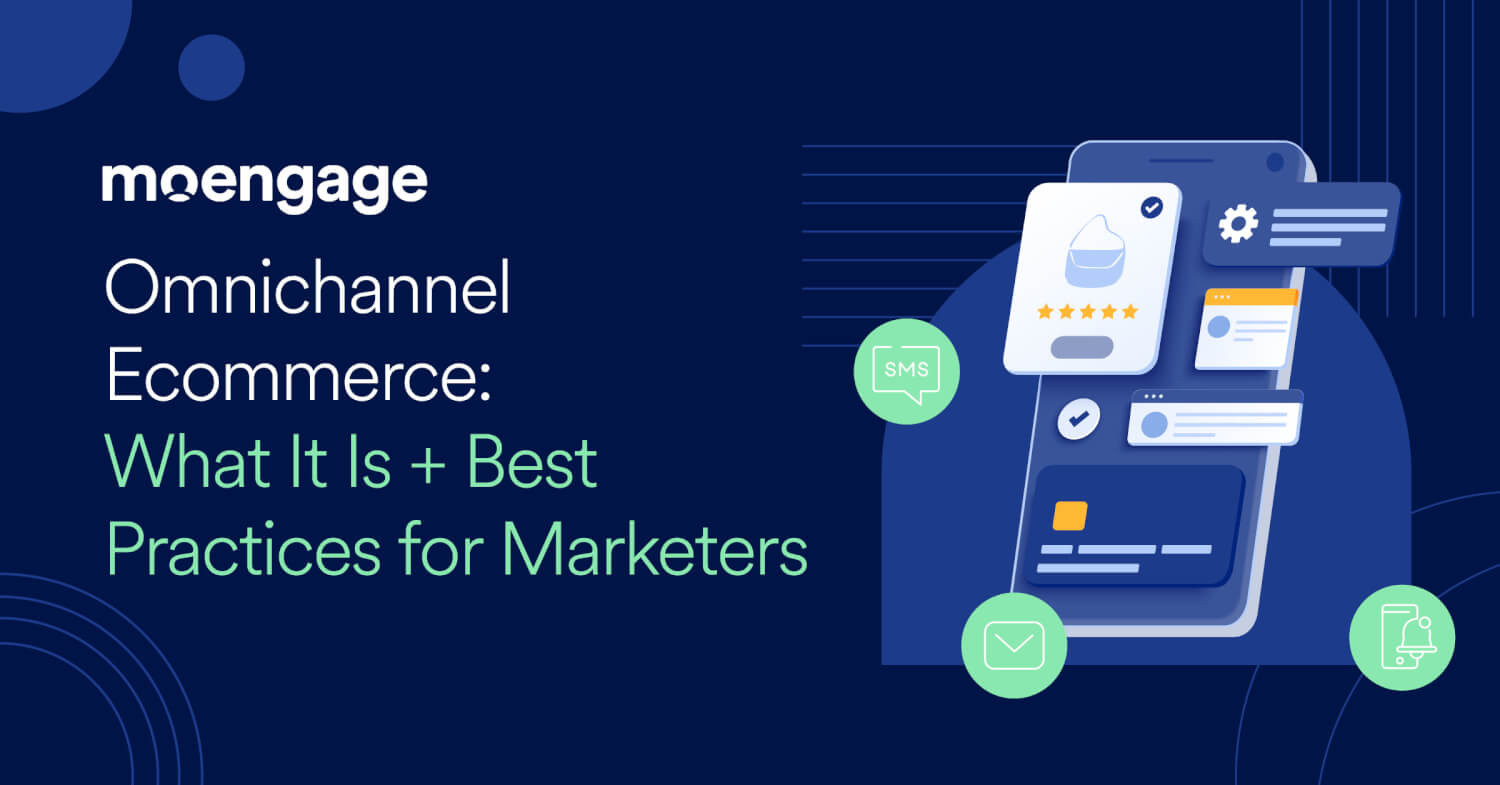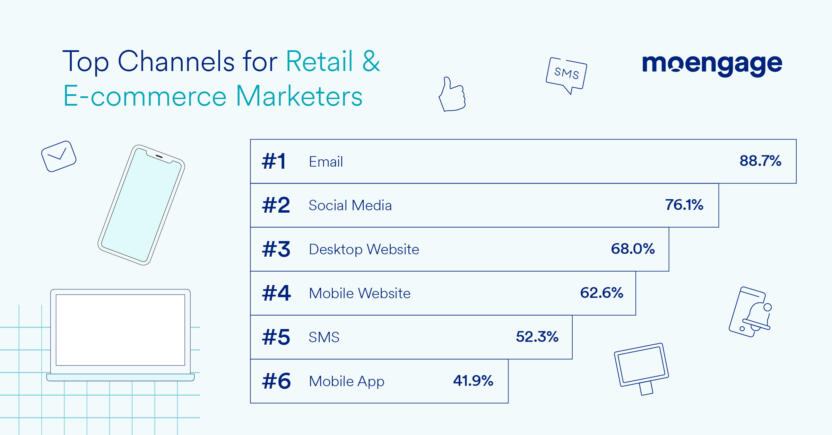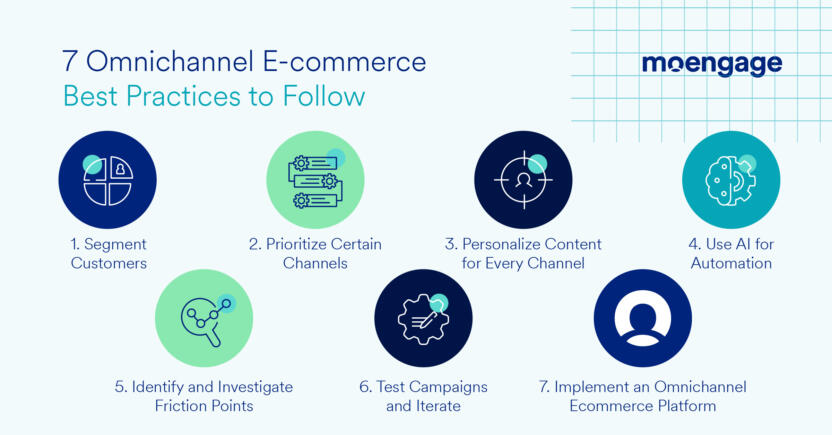Omnichannel Ecommerce: What It Is + Best Practices for Marketers

Ecommerce has fundamentally changed the way we shop, allowing consumers to buy goods and services from their home desktop computers. Since then, ecommerce has boomed, expanding to mobile as the technology developed.
Eventually, customers went from shopping on their desktop to shopping on their smartphones from the comfort of their living rooms, beds, and — yes — even bathrooms. Now, more people shop on mobile than desktop by a fair margin. As of 2024, mobile device usage accounts for nearly 60% of the total market share worldwide against desktops (38%) and tablets (2%).
With so many digital channels at your customers’ disposal, it’s crucial that as an ecommerce marketer, you provide them with a unified, cohesive experience that flows seamlessly between all online and offline channels.
To help brands meet the fast pace that the modern market demands, we explore how they can deploy an omnichannel strategy for their ecommerce marketing efforts by covering the top channels they need to use and the best practices to follow.
What is Omnichannel Ecommerce?
In marketing, omnichannel ecommerce refers to the process of delivering shopping experiences that leverage all available touchpoints. It’s a customer engagement strategy that aims to make transitions between channels seamless, making the overall experience familiar no matter how and where customers connect.
Modern customers prefer omnichannel experiences, and consumer purchase behavior supports this. According to RetailDive, omnichannel campaigns result in a 250% higher purchase rate than their single-channel counterparts.
Ecommerce is a highly competitive industry where brands rely on active engagement and high retention rates to survive. An omnichannel strategy ensures your brand remains on the top of the mind of every customer as it allows you to communicate the right messaging at the right time, to eventually build brand loyalty and advocacy.
Why an Omnichannel Approach is Critical for Ecommerce Marketing
According to The State of Cross-Channel Marketing the top objectives of ecommerce and retail marketers for using an omnichannel strategy are finding new customers (54.1%), increasing customer engagement/loyalty (49.6%), and retaining existing customers (41.9%).
An omnichannel approach leads to a customer-centric experience that empowers customers to connect with your brand via their preferred channels. It also opens up avenues for personalization that deliver relevant experiences your customers love — and want to stick around for.
This is critical in driving engagement with your brand and eliciting conversions.
Below, we look at why an omnichannel marketing strategy is essential for your ecommerce brand.
- Enables deep personalization: Creating omnichannel journeys across multiple touchpoints gives you more freedom in crafting your campaigns and working towards optimizing traction. This allows you to personalize the overall experience and individual campaigns to your customers’ preferences to maximize engagement.
- Empowers data-driven insights: Having all your customer data unified in a single place means you get a holistic view of the customer, one that allows you to understand their activity and behavior more clearly. Collecting omnichannel data empowers deep insights that lead to meaningful, data-driven improvements to your campaigns, strategy, and tech stack.
- Creates a cohesive, unified experience across channels: Providing customers a seamless, familiar experience no matter the touchpoint they use ensures they can browse products, add items to their cart, and complete a purchase from any channel, picking up conveniently where they last left off no matter how they choose to connect.
- Allows you to respond in real-time: Having an omnichannel approach allows you to use the right channel, messaging, and message timing when sending across any communication to your customers. You can even use omnichannel analytics to predict customer actions ahead of time and send communication accordingly. This makes your campaigns more impactful.
- Improves retention and develops brand loyalty: Connecting with customers across channels and sending communication in sync allows you to develop rapport with your customers and foster loyalty. An omnichannel approach helps you weave loyalty programs, promotional offers, and even gamified elements into your communication strategy to keep customers engaged with your brand.
Ultimately, an omnichannel approach allows you to put customers at the center of the experience so you can build experiences they’ll love (and come back for more of).
Top 6 Channels Used for Successful Omnichannel Ecommerce Campaigns
Omnichannel ecommerce marketing is all about making online shopping experiences convenient and accessible by integrating all the channels so that customers can switch seamlessly between them. This allows brands to achieve their objectives such as raising brand awareness, customer acquisition, and retention.
But choosing — and prioritizing — those channels can be extremely challenging. However, knowing what channels other Retail & Ecommerce marketers are using can help you get an idea of what channels to prioritize, as well as help you set performance benchmarks. Beyond that, you’ll need to hone in on your customer insights to pick relevant channels.
According to feedback from our recent survey, the following channels were most popular among Retail & Ecommerce marketers for driving customer engagement:
- Email (88.7%)
- Social Media (76.1%)
- Desktop Website (68.0%)
- Mobile Website (62.6%)
- SMS (52.3%)
- Mobile App (41.9%)

With that in mind, let’s explore why ecommerce marketers consider these channels so valuable to their strategy and what makes them particularly useful from a customer engagement perspective.
1. Email
Email has remained a staple channel for ecommerce brands, and it’s been the primary channel for brands undergoing digital transformation (even before they’ve explored the full potential of omnichannel marketing).
Email campaigns are relatively cheap to execute and cast a wide net, making them ideally suited for marketing products, sending promotional offers, and sharing news and service updates. You can even use emails to remind shoppers about items left in their cart, promote relevant products based on their browsing history, and offer deals associated with items they have shown interest in.
Since email campaigns have such low implementation costs, are ideally suited for automation, and are relatively easy to manage compared to other alternatives, they are an ideal channel to use for enterprise-level companies that need to engage customers at scale.
2. Social Media
Social media has been a driving force in ecommerce for some time. Ecommerce brands have been using social media as a lead funnel engine to increase brand awareness and engagement.
In recent years, though, an even more important aspect of social media engagement has emerged in the form of Shops on Facebook and Instagram. Even TikTok has followed suit with their own TikTok Shop, enabling customers to make purchases in-app, while consuming their favorite content. The ability to make social media posts directly shoppable adds even more touchpoints for conversion. It also empowers brands to orchestrate more seamless journeys, ones that require less flipping between channels.
More than anything, social media has been an invaluable lead-generation tool for ecommerce marketers, helping them gain exposure and acquire customers by targeting and re-targeting ads. You can string together different campaigns across channels such as push notifications, email, and SMS, along with your social ad campaigns to elevate your omnichannel strategy.
3. Desktop Website
Despite the rise in mobile engagement, desktop websites remain a core channel for most ecommerce marketers.
That’s because a website typically does it all; it allows customers to browse your products and services, make purchases, and learn about your brand. They also often provide the largest, most clear picture and formatting for content. Customers can view the product, its details, and shipping information on a single screen, and can easily compare products and prices with more clarity.
For marketers, a desktop website is ideally suited for collecting information about anonymous visitors who show an interest in your brand. You can then use personalized web experiences and messaging to nudge them to register on your platform or sign up to receive communication on other engagement channels, such as an app, email, or SMS
At the same time, a desktop website is often equipped for direct sales and can be used to drive immediate conversions. With intelligent on-site messaging, brands can also send personalized recommendations based on behavior, location, and affinity.
4. Mobile Website
According to Statista, worldwide mobile website traffic accounted for nearly 55% of all website traffic at the end of 2023. With consumers constantly switching between channels in their buying journey and an overall rise in mobile device usage, your mobile website is just as important as any other touchpoint (if not more so).
It’s crucial that the experience on your mobile website is familiar and recognizable, with the same features, capabilities, and overall feel as your other digital channels. Modern consumers aren’t just going there to browse and compare products, they’re also going there to make purchases.
A mobile website is also a great place to direct customers towards an app download, as they’ve already shown a desire to use their smartphone to connect with you. Make sure you provide a personalized experience from start to finish to incentivize them to download your app (where you can then initiate in-app messaging and mobile push campaigns).
Whether customers are here to browse, buy, or simply stay connected with your brand, it’s crucial that your mobile website is optimized to have fast load times, responsive pages, properly sized text and images, and personalized elements that ensure customers get an ideal experience.
5. SMS Messaging
SMS is an excellent complement to other digital engagement channels. As a very direct form of messaging, it has high open and click-through rates when used for the right types of messages.
SMS messaging is best deployed for service updates that inform customers on the status of payments, orders, and deliveries. For example, SMS alerts that provide transactional alerts when an order is processed will help customers stay in the know about their order, increasing quality of service and customer satisfaction.
In some cases, SMS is also a great tool for re-engaging customers and bringing them back to your app or website.
6. Mobile App
For many ecommerce brands, mobile apps have now become an important channel for B2C marketing, with brands developing their apps in-house with integrated loyalty programs, customer support options, and more. According to data from Statista, mobile app revenue has grown from 254 billion in 2019 to 522 billion in 2024.
When deployed properly, mobile apps are designed (and poised) to drive engagement, foster brand loyalty, and enable conversions. However, the user interface and overall in-app experience needs to be familiar to your desktop website and mobile website, so that it’s easy for customers to navigate through.
You can use mobile push notifications to bring customers back to your app, and in-app messaging to help them navigate the app and nudge them to convert.
7 Omnichannel Ecommerce Best Practices to Follow
Executing an airtight omnichannel marketing strategy for an ecommerce brand is no easy task. It means consolidating all channels into a single, cohesive strategy that allows customers to reach you from wherever they are. Even more importantly, it has to drive conversion opportunities at all of these touchpoints.
But what do you actually need to keep in mind when building and executing your omnichannel ecommerce strategy?

Below, we look at omnichannel ecommerce marketing best practices that will ensure you’re able to deliver campaigns that resonate with your customers.
1. Segment customers based on their buyer personas
Not all of your customers will behave the same or be motivated by the same things, which makes it very difficult to deliver to each individual customer what they actually want.
Customer segmentation allows you to identify common groups of customers so you can speak more directly to their specific needs and preferences. This will help you decide how to customize your omnichannel flows and messaging for different customer groups so you can maximize engagement.
2. Prioritize channels based on customer preferences
The primary requirement of an omnichannel approach is adjusting your mindset from campaign-centric to customer-centric. Determining what channels are a priority, and how best to structure different customer journeys needs to be reflective of your customers and their preferences.
Really ask yourself: How are our customers interacting with our brand? Which channels are they coming from? Which channels are they converting or dropping off from?
Your chosen communication channels should parallel their priorities. Use A/B testing to constantly experiment with different channels and journey flows. Make sure you prioritize the channels and pathways that are most relevant and impactful.
3. Personalize content for every channel you use
Different channels are best suited for different types of messages. Rather than blasting out campaigns that use the same formatting and media across all channels, leverage each channel’s unique features and capabilities to get the most value out of them.
For example, mobile push campaigns will need to be more copy-reliant, leveraging short, engaging messaging to hook the reader’s attention and elicit immediate action. On the other hand, email campaigns can include large bodies of text, as well as more dynamic elements like images, videos, timers, and even games.
Make sure that your campaigns are getting the most out of each channel you’re using as part of your omnichannel marketing strategy. After all, all of these channels should be leveraged to communicate uniquely with your customers and foster deeper engagement. Beyond that, ensure you’re also personalizing your omnichannel campaigns to better connect with your customers.
4. Automate your omnichannel marketing efforts with AI and machine learning
Operating an omnichannel marketing strategy and running individual omnichannel campaigns manually can be a time-consuming and burdensome task for your team, especially if you are still using outdated or disjointed systems. There are also higher chances of human errors.
To improve speed and efficiency at all stages of the process, you should look for a customer engagement solution with AI and machine learning capabilities to help them create, deploy, and optimize campaigns with A/B testing.
AI can also empower you to predict key customer actions, craft optimized customer journeys, and generate relevant copy for your messages.
5. Identify and investigate friction points to isolate areas for improvement
To maximize omnichannel engagement, your brand needs to eliminate friction points and make it simple and seamless for customers to connect with your brand.
Use customer activity data and collect customer feedback to learn what elements of the buying journey cause customers the most frustration and lead to drop-offs. Is messaging stilted? Are there issues with the UI in your mobile app?
Then use this information to create experiences and campaigns that deliver customers streamlined, optimized experiences that they’ll love. Refocus your analysis across your digital touchpoints and examine them like a customer would so that you can make the changes they would want to see.
6. Test campaign performance and make regular improvements
Customer behavior is dynamic and constantly changes (sometimes on a whim). To keep pace, you’ll need to continue iterating your omnichannel strategy to ensure you keep customers interested and engaged. Constantly check and update your messaging, adjust the customer journey flows, and try different channels to see what works best.
Set actionable goals and determine KPIs that allow you to measure your ability to reach these objectives. Analyze the overall performance of your strategy regularly and use dynamic A/B testing to compare the performance of different omnichannel campaigns. Then, leverage these insights to make quality improvements and drive increased conversions.
7. Implement an Omnichannel Ecommerce Platform
According to feedback from Retail & Ecommerce marketers, a little over 21% of companies use spreadsheets to manually analyze their cross-channel analytics data. Either they don’t use an all-in-one customer engagement platform or rely heavily on a legacy player.
Legacy systems are often outdated and fail to keep pace with modern customer demands or your team’s internal needs.
Instead, you must rely on an omnichannel ecommerce platform that offers automation capabilities, consolidates all your data, and provides self-serve dashboards. This will help you to develop a clearer understanding of customer actions, campaigns, and journeys, gain more flexibility with campaign testing, and deliver impactful omnichannel campaigns with shorter go-to-market times.
Enhance Your Omnichannel Ecommerce Strategy With MoEngage
Ecommerce, facing a rapid evolution fueled by mobile device adoption, is at the forefront of these advancements, and the competition isn’t going to slow down. Ecommerce brands need to have the courage to evolve with modern customers and leverage the different channels at their disposal. Brands that can adapt to customer preferences and provide seamless digital experiences are being rewarded with higher retention and revenue.
MoEngage’s Customer Engagement Platform enables you to leverage an omnichannel marketing approach that connects with your customers wherever they are, making each touchpoint as impactful as possible.
We help Retail & Ecommerce brands like yours increase traction at each stage of the customer journey, guide customers toward conversion events, and make as many touch points shoppable as possible.
Schedule a demo today to learn how MoEngage can power personalized, omnichannel marketing campaigns that your customers will love.














